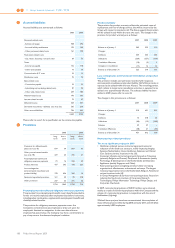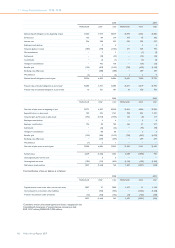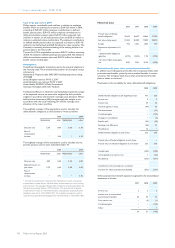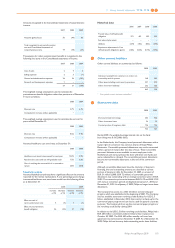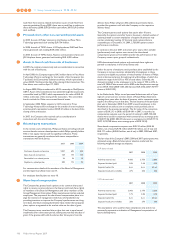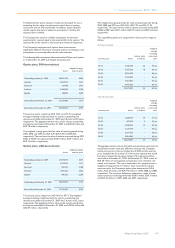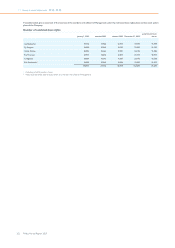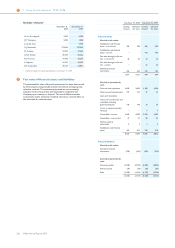Philips 2009 Annual Report Download - page 197
Download and view the complete annual report
Please find page 197 of the 2009 Philips annual report below. You can navigate through the pages in the report by either clicking on the pages listed below, or by using the keyword search tool below to find specific information within the annual report.
Certain Philips group companies have also been named as defendants, in
proposed class proceedings in Ontario, Quebec and British Columbia,
Canada along with numerous other participants in the industry. Philips
intends to vigorously oppose these claims, and the proceedings remain
at a preliminary stage. At this time, no class proceeding has been
certified and no statement of defense has been filed.
Due to the considerable uncertainty associated with these matters, on
the basis of current knowledge, the Company has concluded that
potential losses cannot be reliably estimated with respect to these
matters. An adverse final resolution of these investigations and litigation
could have a materially adverse effect on the Company’s consolidated
financial position, results of operations and cash flows.
Optical Disc Drive (ODD)
On October 27, 2009, the Antitrust Division of the United States
Department of Justice confirmed that it had initiated an investigation
into possible anticompetitive practices in the Optical Disc Drive (ODD)
industry. Philips Lite-On Digital Solutions Corp. (PLDS), a joint venture
owned by the Company and Lite-On IT Corporation, as an ODD
market participant, is included in this investigation. PLDS is also subject
to similar investigations outside the US relating to the ODD
market. PLDS and Philips intend to cooperate with the authorities in
these investigations.
Subsequent to the public announcement of these investigations in 2007,
the Company, PLDS and Philips & Lite-On Digital Solutions USA, Inc.,
were named as defendants in at least two class action complaints filed in
the United States District Court for the Northern District of
California. Several additional complaints were filed against other ODD
manufacturers in the Northern District of California and at least one
other United States District Court. These actions allege
anticompetitive conduct by manufacturers of ODDs, seek treble
damages on behalf of direct purchasers of ODDs, and may involve joint
and several liability among the named defendants.
These matters are in their initial stages and due to the considerable
uncertainty associated with these matters, on the basis of current
knowledge, the Company has concluded that potential losses cannot be
reliably estimated with respect to these matters. An adverse final
resolution of these investigations and litigation could have a materially
adverse effect on the Company’s consolidated financial position, results
of operations and cash flows.
25 Stockholders’ equity
Common shares
As of December 31, 2009, the issued and fully paid share capital consists
of 972,411,769 common shares, each share having a par value of
EUR 0.20.
Preference shares
The ‘Stichting Preferente Aandelen Philips’ has been granted the right to
acquire preference shares in the Company. Such right has not been
exercised. As a means to protect the Company and its stakeholders
against an unsolicited attempt to acquire (de facto) control of the
Company, the General Meeting of Shareholders in 1989 adopted
amendments to the Company’s articles of association that allow the
Board of Management and the Supervisory Board to issue (rights to
acquire) preference shares to a third party. As of December 31, 2009,
no preference shares have been issued.
Option rights/restricted shares
The Company has granted stock options on its common shares and
rights to receive common shares in the future (see note 30).
Treasury shares
In connection with the Company’s share repurchase programs, shares
which have been repurchased and are held in treasury for (i) delivery
upon exercise of options and convertible personnel debentures and
under restricted share programs and employee share purchase
programs, and (ii) capital reduction purposes, are accounted for as a
reduction of stockholders’ equity. Treasury shares are recorded at
cost, representing the market price on the acquisition date. When
issued, shares are removed from treasury stock on a first-in, first-out
(FIFO) basis.
Any difference between the cost and the cash received at the time
treasury shares are issued, is recorded in capital in excess of par value,
except in the situation in which the cash received is lower than cost and
capital in excess of par has been depleted.
The following transactions took place resulting from employee option
and share plans:
2008 2009
Shares acquired 273 2,128
Average market price EUR 24.61 EUR 19.10
Amount paid − −
Shares delivered 4,541,969 4,477,364
Average market price EUR 23.44 EUR 13.76
Amount received EUR 52 million EUR 32 million
Total shares in treasury at end
of year 47,577,915 43,102,679
Total cost EUR 1,263 million EUR 1,162 million
In order to reduce share capital, the following transactions took place in
2008; in 2009 there were no transactions to reduce share capital:
2008 2009
Shares acquired 146,453,094 −
Average market price EUR 22.52 −
Amount paid EUR 3,298 million −
Reduction of capital stock 170,414,994 −
Total shares in treasury at
year-end 1,851,998 1,851,998
Total cost EUR 25 million EUR 25 million
Net income and distribution from retained earnings
A proposal will be submitted to the General Meeting of Shareholders to
pay a dividend of EUR 0.70 per common share, in cash or shares at the
option of the shareholder, against the net income for 2009 and the
retained earnings.
Limitations in the distribution of stockholders’ equity
Pursuant to Dutch law, limitations exist relating to the distribution of
stockholders’ equity of EUR 1,255 million (2008: EUR 1,296 million).
Such limitations relate to common stock of EUR 194 million (2008:
EUR 194 million) as well as to legal reserves required by Dutch law
included under revaluation reserves of EUR 102 million (2008: EUR 117
million), retained earnings of EUR 829 million (2008: EUR 985 million)
and other reserves of EUR 130 million (2008: nil, as the amount was a
loss).
In general, gains related to available-for-sale financial assets, cash flow
hedges and currency translation differences cannot be distributed as
part of stockholders’ equity as they form part of the legal reserves
protected under Dutch law. By their nature, losses relating to available-
for-sale financial assets, cash flow hedges and currency translation
differences, reduce stockholders’ equity, and thereby distributable
amounts.
Therefore gains related to available-for-sale financial assets (2009:
EUR 120 million) and gains related to cash flow hedges (2009: EUR 10
million), representing an aggregate amount of EUR 130 million included
in other reserves, limit the distribution of stockholders’ equity. The loss
related to currency translation differences (2009: EUR 591 million) also
reduces distributable amounts.
The legal reserve required by Dutch law of EUR 829 million (2008:
EUR 985 million) included under retained earnings relates to
investments in affiliated companies.
26 Cash from (used for) derivatives and securities
A total of EUR 35 million cash was paid with respect to foreign exchange
derivative contracts related to financing activities (2008: EUR 337
million inflow; 2007: EUR 385 million inflow) with the remaining EUR 4
million used to attain a short-term convertible note.
11 Group financial statements 11.12 - 11.12 25 26
Philips Annual Report 2009 197



